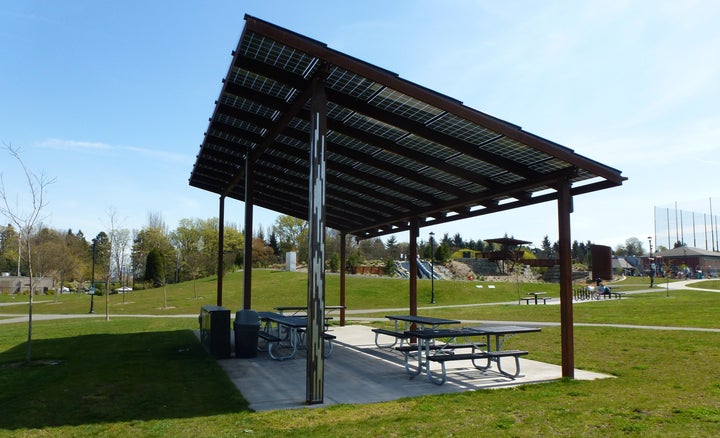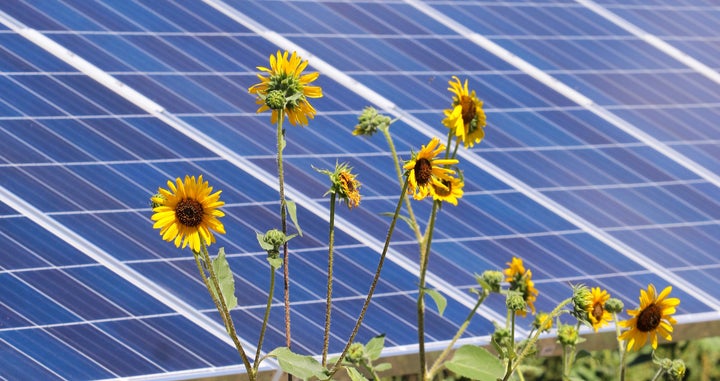Solar panels aren’t just for Arizonans living in sprawling ranch houses anymore.
Homeowners who lack adequate roof space or who enjoy the shade of big trees -- even condo owners and renters such as Joe and Vanessa Goldberg of notoriously rainy Seattle -- are now teaming up with their neighbors to buy electricity from shared solar power projects.
"Because we rent, we don't really have the option of putting solar on our house," said environmentally conscious Joe, 35, who once made a local move using only bike trailers.

Like a growing number of Americans, the Goldbergs decided to invest in a community solar project. Solar-paneled picnic shelters in their neighborhood's Jefferson Park feed the local electricity grid. The couple purchased two of the solar units, and now receive credits on their electric bills for their portion of the solar power produced.
Much like a P-patch provides plots for people lacking their own planting space, emerging community gardens "open up solar's benefits to the masses," said Kate Laursen, a spokeswoman for SunShare, a community solar developer with gardens in Colorado and Minnesota.
Overall, she noted, more than three-quarters of households in the U.S. are unable to install a rooftop solar system on their own home. But for residents in at least 24 states, according to a June report published by market analysis and advisory firm GTM Research, community solar gardens are emerging as an option. In fact, power generated by community solar in the U.S. is predicted to more than double between 2015 and 2016, as more states, utilities and companies get on board. (New rules promoting community solar, for example, are expected to be finalized soon in Maryland.)
Momentum may have been further catalyzed earlier this month in Paris, where 195 nations agreed to a global accord to phase out climate-changing fossil fuels.
"This shows that the world is on board to solve this massive challenge. Now we have to bring the work home and make as much progress locally as we can to meet the commitments agreed upon in Paris," said Jodie Van Horn, director of Sierra Club's Ready for 100% campaign, which is focused on the deployment of clean energy solutions. She highlighted San Diego's commitment, announced on Tuesday, to move entirely to renewable energy in the next 20 years.
Community solar and other shared renewables such as wind are a critical part of the mix in San Diego and elsewhere, Van Horn said.
"Real leadership needs to be demonstrated in our communities," she added. "We all have a role to play and we all will benefit from this transition."
Rhona Templeton, 22, a recent college graduate living in Minneapolis, expressed her excitement for the opportunity to contribute, despite her meager means. She recently signed on to a local community solar project launched by SunShare that is scheduled to go active this spring -- although it may do so sooner.
"They're able to do more construction because it hasn't been snowing in Minnesota," she said, recognizing that such weather abnormalities may reflect a global pattern that scientists predict will become more commonplace with the changing climate. Reducing fossil fuel-based energy to help fight climate change, Templeton said, was a large part of her motivation to participate. Of course, trimming her electric bill added to the draw.

"The financial savings we see today will only grow as the costs of wind and solar continue to drop," Van Horn said. The price of solar panels per watt of generating capacity has already plummeted from $4 in 2006 to about 50 cents today.
The Goldbergs haven't earned enough to make up for their investment in Seattle, but that hasn't curbed their enthusiasm.
"We were willing to go a little out of our way financially because it seemed like a great way to participate in the community and to do something good for the Earth that wouldn't normally be available to us as renters," Joe said. "I'm optimistic, in the long run, about society's ability to cope with climate change. I think that as the problem worsens, incentives will continue to get bigger to do something about it."
The Jefferson Park picnic shelter project is currently one of four community solar efforts in Seattle, each with hundreds of participants, noted Scott Thomsen, a spokesperson with Seattle City Light, the city's publicly owned nonprofit utility.
"We're getting a broader cross-section of our community engaged through community solar," he said, pointing out that while Seattle might not be known for abundant sunshine, it does see just as many rays as Germany -- the world's leading solar user.
What's more, one of Seattle's community solar projects sits on the roof of an affordable housing complex.
"As that moves forward, it is going to help that facility hold down their operational costs," Thomsen added. "And that translates into helping hold down the cost of rent for those tenants."
